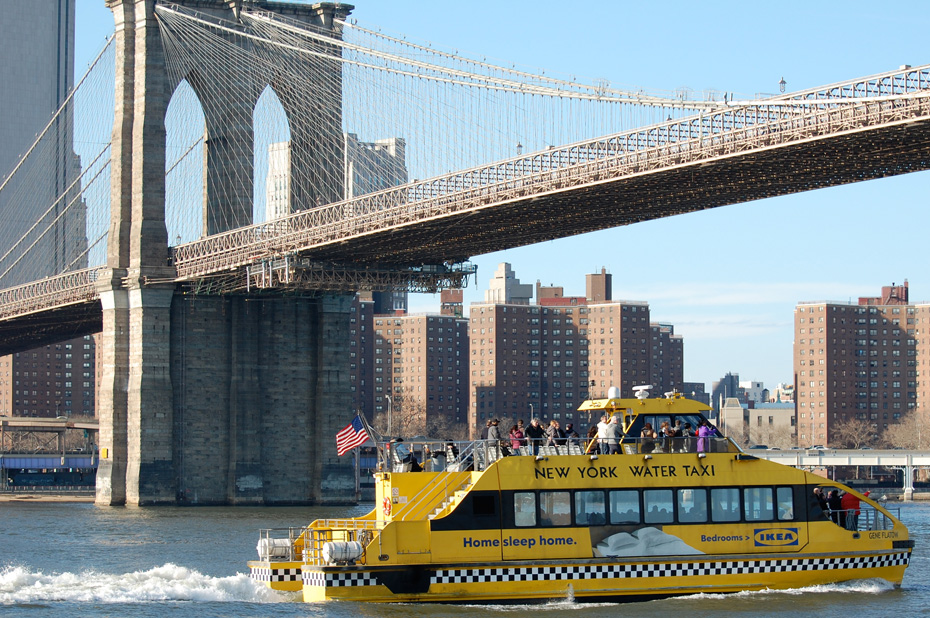Brooklyn Bridge

The Brooklyn Bridge was designed by John A. Roebling. Its construction began in 1869 and was completed in 1883. At the time, it was the longest suspension bridge in the world. The Brooklyn Bridge connects the boroughs of Manhattan and Brooklyn over the East River.
Location
Manhattan – Brooklyn
Hours
24 hours
Tickets
Free
How will you get there?
Subway: Brooklyn Bridge – City Hall Station, lines 4, 5 and 6.
Bus: Lines M9, M15 and M22.
What is nearby?
Federal Hall (1,1 km)
Wall Street (1,1 km)
Chinatown (1,2 km)
Lower East Side (1,4 km)
With a main span of 486.3 meters it was the longest suspension bridge in the world from its inception until 1903, and the first steel cable suspension bridge.




History
Plans to join Brooklyn and Lower Manhattan date back to the early 1800s. When the East River crossing plan was envisioned, Brooklyn, with about 400,000 residents, was more rural than urban.
New York City – which at the time consisted only of Manhattan – had twice the population. The bridge was seen as a solution to overcrowding in Manhattan while it would be a driving force for the growth of Brooklyn.
The bridge would allow people and goods to cross the East River quickly, regardless of weather conditions.
In 1855, John Roebling, the owner of a cable company and famous bridge designer, proposed a suspension bridge over the East River. Roebling had worked out every detail of the bridge, from the granite towers to the four steel cables.
In 1869, while examining sites for the Brooklyn Tower, Roebling had his leg broken on the wharf by an incoming ship. Roebling later died of tetanus as a result of his injuries. Immediately after Roebling’s death, his son, Washington, took over as chief engineer of the Brooklyn Bridge.
Soon after ground was broken on January 3, 1870, work began on the foundations in Manhattan and Brooklyn. The huge 3,000-ton boxes were airtight cylinders in which workers removed layers of silt in an atmosphere of compressed air below the river bed. They dug 24 meters below the river on the Manhattan side, and 13.5 meters below the river on the Brooklyn side. To hasten the descent of the boxes, dynamite was used for the first time in the construction of bridges. The foundations took three years to build.
Fires, explosions, and divers’ illnesses (caused by changes in air pressure affecting blood nitrogen levels), claimed the lives of 20 men, and left Washington Roebling himself paralyzed. Then the younger Roebling, with the help of his wife Emily, directed the construction of the bridge from his home in Brooklyn. With her husband’s help, Emily Roebling studied advanced mathematics and bridge engineering, and was soon making daily visits to the bridge to supervise her husband’s staff, from engineers to builders.
Walking
On May 23, 1883, President Chester Arthur and Governor Grover Cleveland, to whom the Brooklyn Bridge was officially dedicated, arrived before more than 14,000 guests.
Emily Roebling took the first walk over the bridge with a rooster, a symbol of victory, in her arms. After the opening ceremony, anyone with a penny for the toll could cross the Brooklyn Bridge. In its first day, the bridge carried trolley lines, carriages and even animals.
However, in the midst of the new construction, there was a tragedy. On Memorial Day, 1883, a woman walking down the steps on the Manhattan side tripped, and her female company screamed. The scream was the trigger for a rumor that the bridge was about to collapse. In the panic of impending disaster that ensued, 12 people were killed and 35 others were seriously injured.
In September 2021, a two-way protected bike lane opened along the Brooklyn Bridge, repurposing a vehicle lane to accommodate the rise of cycling in New York City.


